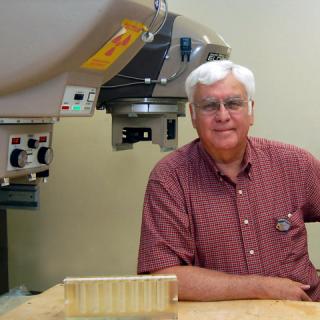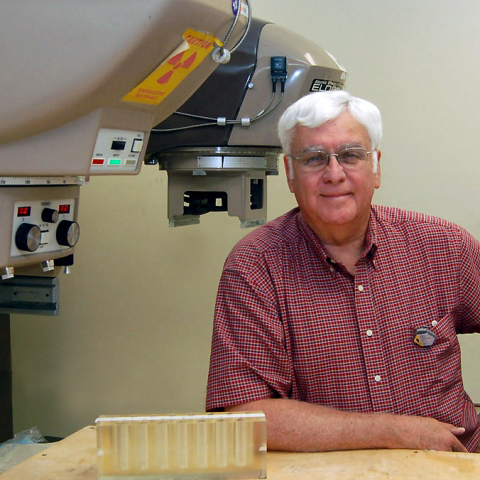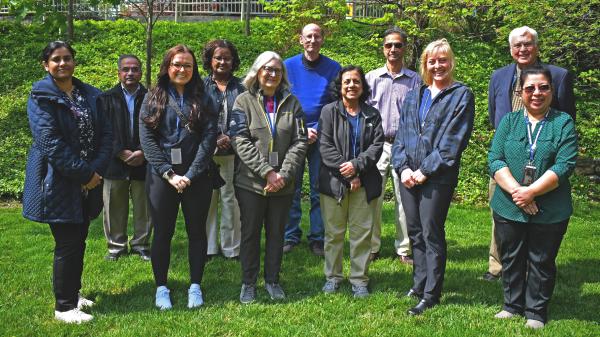
James B. Mitchell, Ph.D.
- Center for Cancer Research
- National Cancer Institute
- Building 10, Room B3B69
- Bethesda, MD 20892-1002
- 240-858-3101
- jbm@helix.nih.gov
RESEARCH SUMMARY
Dr. Mitchell was a radiation biologist whose research focused on evaluation of agents in combination with radiation that either enhances tumor sensitivity or protects normal tissues. He was interested in determining the mechanism of how such agents can alter radiation sensitivity.
Areas of Expertise
Research
Modification of the Radiation Response
My research was directed toward the discovery of ways to modify the radiation response of both normal and tumor tissue. Such modification can be important for the improvement of cancer treatment using ionizing radiation either by protecting normal tissues or enhancing the sensitivity of tumor. Further, identifying means to protect normal tissues, particularly against radiation-induced late effects such as carcinogenesis, is important for countermeasure considerations of large populations exposed to radiation or in patients at risk for second malignancies following successful radiotherapy.
With respect to enhancing the effects of radiation damage to tumors, a number of approaches are being evaluated including molecularly targeted agents and cytotoxic chemotherapeutic agents. The overall objective here is to obtain a therapeutic gain by providing selective radiosensitization in tumors as compared to normal tissues. Admittedly, this has been and continues to be a difficult goal to achieve. We are presently evaluating in human tumor cell lines and xenografts treated with inhibitors such as KRAS mutation inhibitors, vasculogenesis inhibitors, and OxpPhos inhibitors. Studies include the effects of the agent combined with radiation on cell survival, DNA damage repair, and cell cycle perturbations coupled with the effects of the combination on specific signal transduction pathways.
Our laboratory was first to identify nitroxides (lead compound Tempol) as catalytic antioxidants and radiation protectors providing protection against oxidative- and radiation-induced damage. Extensive pre-clinical studies are directed to normal tissue radioprotection using systemically or topically applied Tempol to protect against oral mucositis and salivary gland damage resulting from cisplatin-based chemoradiation in mice without interfering with tumor response. Studies were also directed to better define the mechanism of Tempol-mediated reduction in weight gain in mice. Preliminary findings indicated that chronic supplementation of Tempol in the diet of mice over their life span can reduce body weight without toxicity, decrease cancer, and extend survival when administered immediately after non-lethal total body radiation (TBI). Delaying administration of the Tempol diet 1 month after TBI also enhanced survival and decreased carcinogenesis, suggesting that there may be a considerable "progression" phase of TBI-induced cancer induction that is amenable to modification and/or intervention. We also studied the effects of Tempol on mice gut microflora.
Publications
- Bibliography Link
- View Dr. Mitchell's PubMed Summary.
The antioxidant Tempol transforms gut microbiome to resist obesity in female C3H mice fed a high fat diet
PEGPH20, a PEGylated human hyaluronidase, induces radiosensitization by reoxygenation in pancreatic cancer xenografts. A molecular imaging study
Pharmacological inhibition of HSP90 radiosensitizes head and neck squamous cell carcinoma xenograft by inhibition of DNA damage repair, nucleotide metabolism, and radiation-induced tumor vasculogenesis
Molecular imaging of the tumor microenvironment reveals the relationship between tumor oxygenation, glucose uptake and glycolysis in pancreatic ductal adenocarcinoma
Abemaciclib, a Selective CDK4/6 Inhibitor Enhances the Radiosensitivity of Non-Small Cell Lung Cancer in vitro and in vivo
Biography

James B. Mitchell, Ph.D.
Dr. Mitchell received his Ph.D. from Colorado State University in cellular radiation biology in 1978. He came to the NIH and the Radiation Oncology Branch of the NCI in 1979 and became an independent investigator in 1984. He served as chief of the Radiobiology Section and later as deputy branch chief of the Radiation Oncology Branch. In 1993, he was named chief of the Radiation Biology Branch. In 2010, he received the Failla Award from the Radiation Research Society and in 2015 he received the Gold Medal Award from the American Society of Therapeutic Radiation Oncology.
Dr. Mitchell retired as Chief of the Radiation Biology Branch in May 2025.

